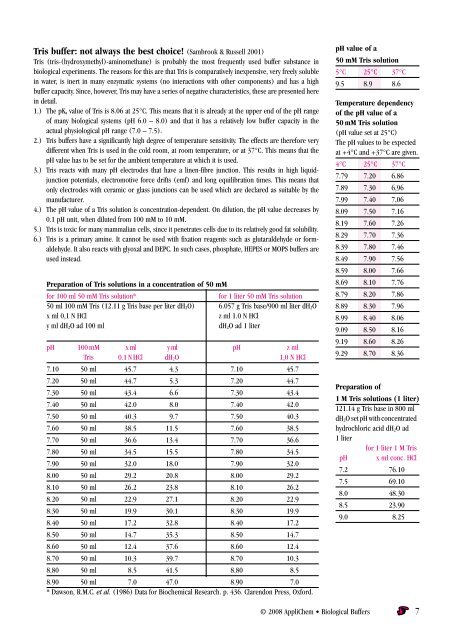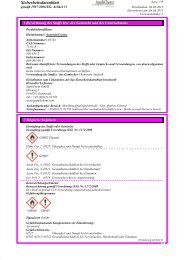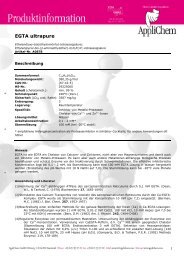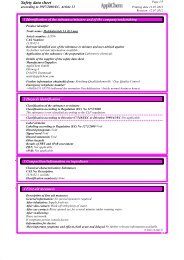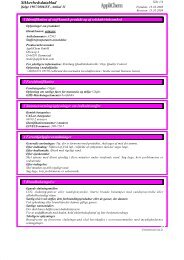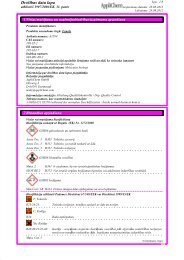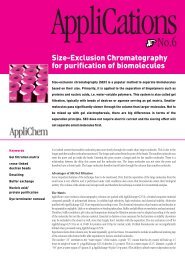Biological Buffers • AppliChem
Biological Buffers • AppliChem
Biological Buffers • AppliChem
You also want an ePaper? Increase the reach of your titles
YUMPU automatically turns print PDFs into web optimized ePapers that Google loves.
Tris buffer: not always the best choice! (Sambrook & Russell 2001)<br />
Tris (tris-(hydroxymethyl)-aminomethane) is probably the most frequently used buffer substance in<br />
biological experiments. The reasons for this are that Tris is comparatively inexpensive, very freely soluble<br />
in water, is inert in many enzymatic systems (no interactions with other components) and has a high<br />
buffer capacity. Since, however, Tris may have a series of negative characteristics, these are presented here<br />
in detail.<br />
1.) The pKa value of Tris is 8.06 at 25°C. This means that it is already at the upper end of the pH range<br />
of many biological systems (pH 6.0 – 8.0) and that it has a relatively low buffer capacity in the<br />
actual physiological pH range (7.0 – 7.5).<br />
2.) Tris buffers have a significantly high degree of temperature sensitivity. The effects are therefore very<br />
different when Tris is used in the cold room, at room temperature, or at 37°C. This means that the<br />
pH value has to be set for the ambient temperature at which it is used.<br />
3.) Tris reacts with many pH electrodes that have a linen-fibre junction. This results in high liquidjunction<br />
potentials, electromotive force drifts (emf) and long equilibration times. This means that<br />
only electrodes with ceramic or glass junctions can be used which are declared as suitable by the<br />
manufacturer.<br />
4.) The pH value of a Tris solution is concentration-dependent. On dilution, the pH value decreases by<br />
0.1 pH unit, when diluted from 100 mM to 10 mM.<br />
5.) Tris is toxic for many mammalian cells, since it penetrates cells due to its relatively good fat solubility.<br />
6.) Tris is a primary amine. It cannot be used with fixation reagents such as glutaraldehyde or formaldehyde.<br />
It also reacts with glyoxal and DEPC. In such cases, phosphate, HEPES or MOPS buffers are<br />
used instead.<br />
Preparation of Tris solutions in a concentration of 50 mM<br />
for 100 ml 50 mM Tris solution* for 1 liter 50 mM Tris solution<br />
50 ml 100 mM Tris (12.11 g Tris base per liter dH2O) 6.057 g Tris base/900 ml liter dH2O<br />
x ml 0,1 N HCl z ml 1.0 N HCl<br />
y ml dH2O ad 100 ml dH2O ad 1 liter<br />
pH 100 mM x ml y ml pH z ml<br />
Tris 0.1 N HCl dH2O 1,0 N HCl<br />
7.10 50 ml 45.7 4.3 7.10 45.7<br />
7.20 50 ml 44.7 5.3 7.20 44.7<br />
7.30 50 ml 43.4 6.6 7.30 43.4<br />
7.40 50 ml 42.0 8.0 7.40 42.0<br />
7.50 50 ml 40.3 9.7 7.50 40.3<br />
7.60 50 ml 38.5 11.5 7.60 38.5<br />
7.70 50 ml 36.6 13.4 7.70 36.6<br />
7.80 50 ml 34.5 15.5 7.80 34.5<br />
7.90 50 ml 32.0 18.0 7.90 32.0<br />
8.00 50 ml 29.2 20.8 8.00 29.2<br />
8.10 50 ml 26.2 23.8 8.10 26.2<br />
8.20 50 ml 22.9 27.1 8.20 22.9<br />
8.30 50 ml 19.9 30.1 8.30 19.9<br />
8.40 50 ml 17.2 32.8 8.40 17.2<br />
8.50 50 ml 14.7 35.3 8.50 14.7<br />
8.60 50 ml 12.4 37.6 8.60 12.4<br />
8.70 50 ml 10.3 39.7 8.70 10.3<br />
8.80 50 ml 8.5 41.5 8.80 8.5<br />
8.90 50 ml 7.0 47.0 8.90 7.0<br />
* Dawson, R.M.C. et al. (1986) Data for Biochemical Research. p. 436. Clarendon Press, Oxford.<br />
pH value of a<br />
50 mM Tris solution<br />
5°C 25°C 37°C<br />
9.5 8.9 8.6<br />
Temperature dependency<br />
of the pH value of a<br />
50 mM Tris solution<br />
(pH value set at 25°C)<br />
The pH values to be expected<br />
at +4°C and +37°C are given.<br />
4°C 25°C 37°C<br />
7.79 7.20 6.86<br />
7.89 7.30 6,96<br />
7.99 7.40 7,06<br />
8.09 7.50 7.16<br />
8.19 7.60 7.26<br />
8.29 7.70 7.36<br />
8.39 7.80 7.46<br />
8.49 7.90 7.56<br />
8.59 8.00 7.66<br />
8.69 8.10 7.76<br />
8.79 8.20 7.86<br />
8.89 8.30 7.96<br />
8.99 8.40 8.06<br />
9.09 8.50 8.16<br />
9.19 8.60 8.26<br />
9.29 8.70 8.36<br />
Preparation of<br />
1 M Tris solutions (1 liter)<br />
121.14 g Tris base in 800 ml<br />
dH2O set pH with concentrated<br />
hydrochloric acid dH2O ad<br />
1 liter<br />
for 1 liter 1 M Tris<br />
pH x ml conc. HCl<br />
7.2 76.10<br />
7.5 69.10<br />
8.0 48.30<br />
8.5 23.90<br />
9.0 8.25<br />
© 2008 <strong>AppliChem</strong> <strong>•</strong> <strong>Biological</strong> <strong>Buffers</strong> 7


